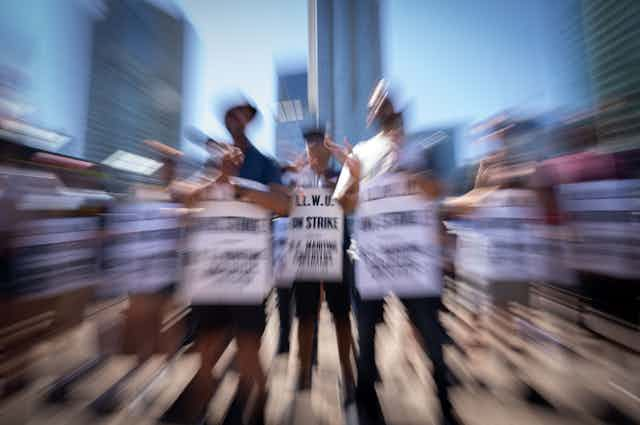Picket lines are often the most visible feature of a labour dispute. And with the recent uptick in strike action across the country — from port workers in British Columbia to grocery chain employees in Toronto — Canadians have been more likely than usual to encounter one.
Picket lines are meant to disrupt business as usual, rally support and communicate a message — all in an effort to increase pressure on employers to reach a negotiated settlement.
While picketing is a legal expressive activity, how the right to picket squares with property rights and civil rights is not straightforward.
The common view is that while picketers may carry signs, they may not — or at least, should not — prevent others from crossing picket lines. The reality is more complicated.
Legal context
Picketing is almost exclusively regulated by courts. Historically, courts did not look kindly upon picketing and police forces were only too eager to enforce injunctions (court orders) or engage in other efforts to dismantle picket lines.
Today, courts are less keen to use the blunt instrument of an injunction to limit picketing. Intervening too quickly in a labour dispute is now seen as unfairly helping one side, namely employers. This shift in approach was heavily influenced by the connection the Supreme Court of Canada has drawn between picketing and freedom of expression.
According to the Supreme Court, picketing “always involves expressive action,” which is protected under the guarantee of freedom of expression in the Charter of Rights and Freedoms. As such, the court ruled that picketing may only be limited to prevent “wrongful acts.”
Courts will consider criminal acts like violence and damage to property as reasons to limit picketing. But wrongful actions also include things like trespassing and nuisance (interfering with others’ lawful right to enter and exit).
Since the main function of a picket line is to discourage others from crossing, delaying others in order to provide the union an opportunity to convey its message is key.
So, how do courts find the right balance between the expressive rights of picketers and the property and civil rights of others — all while ensuring the general safety of everyone involved? Some inconvenience to employers and the public is an essential part of the equation.

Striking a balance
Because the outcomes of judicial interventions are uncertain, employers and unions can benefit from negotiating non-binding picketing protocols in advance of any dispute.
Where they exist, protocols govern how picket lines will operate. For example, an employer may allow picketers to come onto private property to avoid creating dangerous traffic or public safety conditions. Or the parties may agree that people attempting to cross a picket line will be delayed a given amount of time, thereby allowing the union to communicate its message.
In fact, a refusal to even discuss a protocol in advance may work against the refusing party if a request for an injunction is later filed.
While the role of local police in labour disputes varies, it is now common for them to formally take a neutral stance and play no more than a mediating role with regard to public safety. While police are expected to keep the peace, they are not normally authorized to intervene on behalf of either party engaged in the dispute.

When injunctions are issued, police do intervene to uphold court orders. But workers are generally still permitted to delay traffic, often with the proviso that anyone who doesn’t want to hear the union’s message may proceed at will.
Additionally, in issuing an injunction a judge may set further rules, for example, on the number of picketers or where they are permitted to picket.
The same balancing principles apply to secondary picketing (picketing against a third party to increase pressure on the struck employer).
For example, an injunction recently granted against Unifor, the union representing striking Metro grocery workers in the Toronto area, restricted picketing workers from blockading the company’s distribution centres.
Yet the order still permitted picketers some leeway to continue stopping vehicles for a prescribed amount of time. The workers recently ratified a new collective agreement after their month-long strike.
Emotions can run high
Strikes may be inconvenient for the public. For striking workers, they can be highly emotional affairs. If a strike drags on or becomes particularly heated, negotiated protocols and even injunctions may be ignored out of frustration, anger or a sense of urgency.
Besides the legal questions at play, union members also stress moral arguments for respecting picket lines. A refusal to do so can feel like a betrayal, especially when those crossing the line are from within union ranks.
That’s because crossing a picket line almost inevitably weakens the union’s bargaining position, and, ironically, may help to prolong the dispute by alleviating pressure on the employer to come to a negotiated settlement.
“Naming and shaming” replacement workers — known as scabs — also enjoys some constitutional protection.
In short, the politics of picket lines can be complex, especially for members of the public encountering them for the first time.
No one wants a strike or lockout; they are stressful and full of uncertainty. While labour stoppages are typically used as a last resort to overcome a bargaining impasse, they can become lightning rods for unions, employers and members of the public.
Recognizing, however, that competing rights are at play is key to understanding how the law aims to uphold civil and property rights without jeopardizing workers’ freedom of expression.

